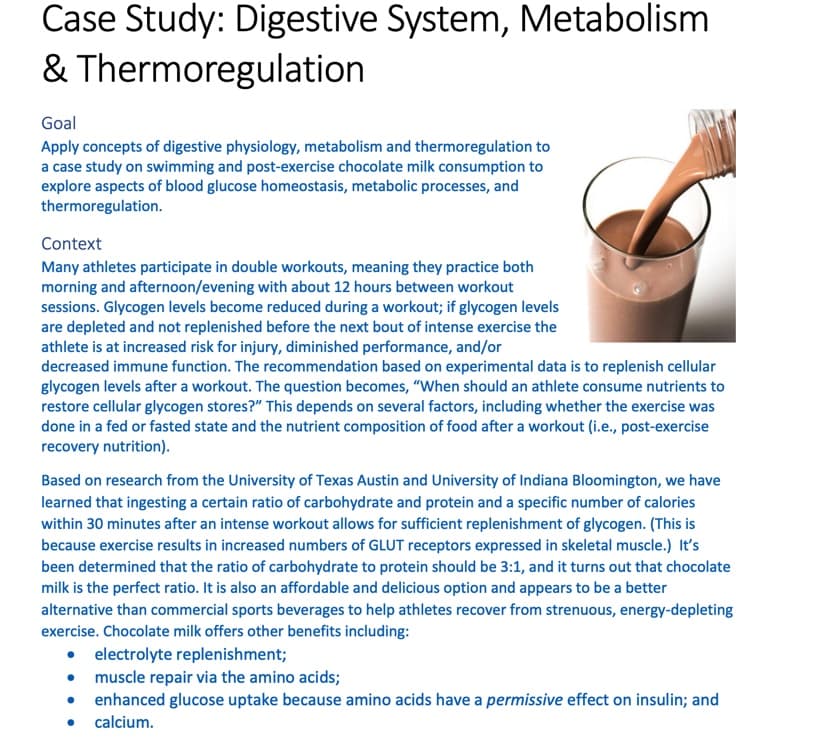What levels of insulin and glucagon would you predict you’d find in Fatima after she ingests the chocolate milk? a. insulin: high / low / none b. glucagon: high / low / none
What levels of insulin and glucagon would you predict you’d find in Fatima after she ingests the chocolate milk? a. insulin: high / low / none b. glucagon: high / low / none
Human Anatomy & Physiology (11th Edition)
11th Edition
ISBN:9780134580999
Author:Elaine N. Marieb, Katja N. Hoehn
Publisher:Elaine N. Marieb, Katja N. Hoehn
Chapter1: The Human Body: An Orientation
Section: Chapter Questions
Problem 1RQ: The correct sequence of levels forming the structural hierarchy is A. (a) organ, organ system,...
Related questions
Question
9. What levels of insulin and glucagon would you predict you’d find in Fatima after she
ingests the chocolate milk?
a. insulin: high / low / none
b. glucagon: high / low / none
please draw a drawing with your explanation and explain what is happening in the drawing. also, please explain why your answer is correct.

Transcribed Image Text:Scenario
Fatima is a member of her local swim team and attends practice Monday - Friday afternoon every day
for 5 years. Fatima has school during the day, eats lunch around 12pm and practices right afterschool at
3pm. The school allows students to have water breaks during the day, but there is not enough time to
snack between lunch and practice. This means that when Fatima begins her workout, she has not eaten
in three hours.

Transcribed Image Text:Case Study: Digestive System, Metabolism
& Thermoregulation
Goal
Apply concepts of digestive physiology, metabolism and thermoregulation to
a case study on swimming and post-exercise chocolate milk consumption to
explore aspects of blood glucose homeostasis, metabolic processes, and
thermoregulation.
Context
Many athletes participate in double workouts, meaning they practice both
morning and afternoon/evening with about 12 hours between workout
sessions. Glycogen levels become reduced during a workout; if glycogen levels
are depleted and not replenished before the next bout of intense exercise the
athlete is at increased risk for injury, diminished performance, and/or
decreased immune function. The recommendation based on experimental data is to replenish cellular
glycogen levels after a workout. The question becomes, "When should an athlete consume nutrients to
restore cellular glycogen stores?" This depends on several factors, including whether the exercise was
done in a fed or fasted state and the nutrient composition of food after a workout (i.e., post-exercise
recovery nutrition).
Based on research from the University of Texas Austin and University of Indiana Bloomington, we have
learned that ingesting a certain ratio of carbohydrate and protein and a specific number of calories
within 30 minutes after an intense workout allows for sufficient replenishment of glycogen. (This is
because exercise results in increased numbers of GLUT receptors expressed in skeletal muscle.) It's
been determined that the ratio of carbohydrate to protein should be 3:1, and it turns out that chocolate
milk is the perfect ratio. It is also an affordable and delicious option and appears to be a better
alternative than commercial sports beverages to help athletes recover from strenuous, energy-depleting
exercise. Chocolate milk offers other benefits including:
electrolyte replenishment;
• muscle repair via the amino acids;
• enhanced glucose uptake because amino acids have a permissive effect on insulin; and
calcium.
Expert Solution
This question has been solved!
Explore an expertly crafted, step-by-step solution for a thorough understanding of key concepts.
This is a popular solution!
Trending now
This is a popular solution!
Step by step
Solved in 5 steps with 1 images

Recommended textbooks for you

Human Anatomy & Physiology (11th Edition)
Anatomy and Physiology
ISBN:
9780134580999
Author:
Elaine N. Marieb, Katja N. Hoehn
Publisher:
PEARSON

Anatomy & Physiology
Anatomy and Physiology
ISBN:
9781259398629
Author:
McKinley, Michael P., O'loughlin, Valerie Dean, Bidle, Theresa Stouter
Publisher:
Mcgraw Hill Education,

Human Anatomy
Anatomy and Physiology
ISBN:
9780135168059
Author:
Marieb, Elaine Nicpon, Brady, Patricia, Mallatt, Jon
Publisher:
Pearson Education, Inc.,

Human Anatomy & Physiology (11th Edition)
Anatomy and Physiology
ISBN:
9780134580999
Author:
Elaine N. Marieb, Katja N. Hoehn
Publisher:
PEARSON

Anatomy & Physiology
Anatomy and Physiology
ISBN:
9781259398629
Author:
McKinley, Michael P., O'loughlin, Valerie Dean, Bidle, Theresa Stouter
Publisher:
Mcgraw Hill Education,

Human Anatomy
Anatomy and Physiology
ISBN:
9780135168059
Author:
Marieb, Elaine Nicpon, Brady, Patricia, Mallatt, Jon
Publisher:
Pearson Education, Inc.,

Anatomy & Physiology: An Integrative Approach
Anatomy and Physiology
ISBN:
9780078024283
Author:
Michael McKinley Dr., Valerie O'Loughlin, Theresa Bidle
Publisher:
McGraw-Hill Education

Human Anatomy & Physiology (Marieb, Human Anatomy…
Anatomy and Physiology
ISBN:
9780321927040
Author:
Elaine N. Marieb, Katja Hoehn
Publisher:
PEARSON